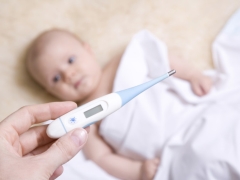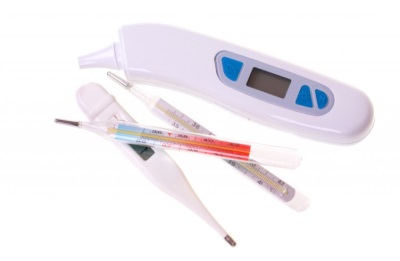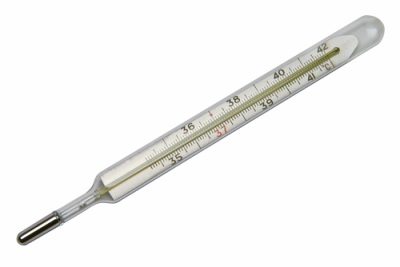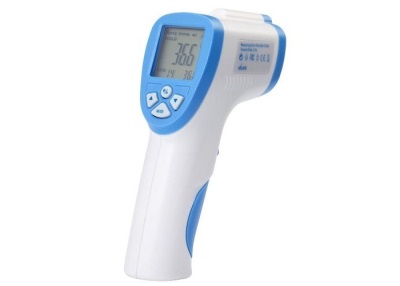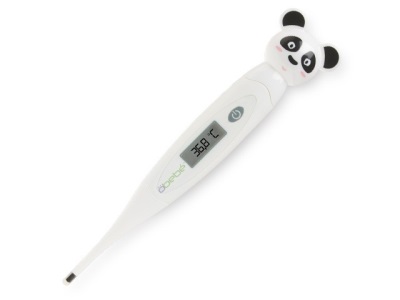Children's thermometer: which thermometer is best for your child?
The thermometer is a mandatory purchase for expectant parents, because without a thermometer at home it is impossible to precisely control the body temperature in children, and this at an early age is very important for timely visit to a doctor and treatment, especially for acute infections.
Modern children's thermometers are very diverse, so before moms and dads there is a difficult choice. To determine which thermometer will be the best for the child, one should find out what are the thermometers used in childhood, and what to look for when buying them.
Types, their pros and cons
Thermometers used to determine body temperature in healthy and sick children are distinguished by their working principle and structure. Let us consider in more detail each type of children's thermometers.
For information on which thermometers are better to measure body temperature, see the transfer of Dr. Komarovsky. The doctor also focuses on the fact that in case of illness the most important thing is to monitor the temperature dynamics.
Mercury
The most common and easy to use are thermometers, inside of which is a sealed flask with mercury.
Features of mercury children's thermometers are:
|
pros |
disadvantages |
|
The use of such thermometers ensures accurate determination of body temperature in a baby with an accuracy of up to 0.1ºWITH |
The device is very fragile because it is made of glass. |
|
Such thermometers are universal, as they can be used orally, axially and rectally |
Damage to such a thermometer is not safe for the child. |
|
Devices are well tolerated treatment disinfectants |
To get the result, the thermometer has to be held for quite a long time (about 10 minutes) |
|
Such thermometers are sold everywhere and are distinguished by low prices. |
Electronic
Such thermometers are distinguished by the presence of a sensitive sensor at one end, which responds to different ambient temperatures. When this embedded sensor comes into contact with the child’s body, the body temperature is determined, and the data is transmitted in digital form to the display, therefore such thermometers are often called digital.
One of the varieties of electronic thermometers are models in the form of nipples. They are given to suck on the baby for 3-5 minutes, and then look at the scoreboard placed on the pad where the measurement result appears.
Here are the main features of electronic thermometers for children:
|
pros |
disadvantages |
|
In such thermometers there is no glass, and also there is no mercury, therefore they are safer for children |
The accuracy of determining the temperature of such thermometers is lower than that of mercury thermometers - up to 0.5ºWITH |
|
Most models are made of durable plastic, so these thermometers are protected from damage and damage from falling. |
Some models cannot be wetted and treated with disinfecting materials, and if replaceable caps are provided for in the thermometer, this leads to additional costs. |
|
Measurement results can be evaluated in 1-3 minutes. |
Digital thermometers cost more than mercury-filled models. |
|
The thermometer notifies by the sound signal when the temperature determination is complete. |
In case of loose contact with the body, the measurement data will be incorrect. |
|
This thermometer is universal because it allows you to find out the temperature orally, in the folds of the skin and in the rectum |
If you measure the temperature in the mouth after meals, the result will be unreliable |
|
There are waterproof models that can be used to determine the temperature of the water for bathing a baby. |
The devices are powered by batteries, which can be discharged at the wrong time and require regular replacement. |
|
Many thermometers have additional functions, for example, they store measurement data, change the temperature scale, highlight the screen. |
Dummy may not like babies who do not recognize the nipple |
Infrared
Such modern thermometers determine the infrared radiation that comes from the body of a child. In the infrared thermometer there is a sensitive element that captures this radiation, and the data converted to degrees appears on the display. Another name for such thermometers is “pyrometer”.
All thermometers of this type are divided into ear (they measure the temperature in the ear of the child or on the skin of the temples), frontal (such thermometers measure radiation on the skin of the forehead) and non-tactical (they are able to determine the temperature at a distance of 4-15 cm from the child's skin).
Among the features of infrared thermometers are the following:
|
pros |
disadvantages |
|
Infrared thermometer easy to use |
The error of measurement results in such a thermometer is from 0.1 to 1ºWITH |
|
The measurement result appears on the display after a few seconds. |
If you use an ear or frontal thermometer, they can not measure the temperature in other places, other than those permitted by such devices |
|
Such thermometers are classified as safe because they do not contain mercury or glass parts. |
Baby movements during the measurement or baby's crying affect the results. |
|
Non-contact models are very convenient for determining the temperature in an infant and a sleeping child. |
Ear thermometer may have a large tip, unsuitable for determining the temperature in infants |
|
Due to its compact size and low weight, such a thermometer is easy to store and transport. |
When otite, the ear thermometer data will be incorrect. |
|
Most models of infrared thermometers work in several modes, determining not only the temperature of the baby’s body, but also the temperature of any external heat source, for example, a mixture in a bottle, water in a bath, air in a room |
The use of an ear thermometer requires the purchase of disposable pads |
|
Many thermometers of this type have additional options, including storing measurement data, automatic shutdown, display backlighting, battery charge indication, and others. |
Improper use of the ear thermometer threatens ear injury |
|
In some models there is a laser pointer, which allows to more accurately measure the temperature in the right place. |
Infrared thermometers are quite expensive |
|
Devices are sold in a convenient case. |
To re-determine the temperature required to wait for the thermometer to turn off |

Bracelet thermometer
Such a variant of the children's thermometer is fixed on the child’s hand and constantly records the temperature due to the presence of a sensor inside the wristband, transmitting the data to the mother’s phone.
What is interesting such thermometers:
|
pros |
disadvantages |
|
The thermometer shows the temperature of the child constantly, even while sleeping or walking |
The operation of the device requires a smartphone and android from 4.4 |
|
There is no alcohol, mercury and glass in the device |
Communication with the thermometer is periodically lost |
|
The accuracy of the device is quite high - up to 0.1ºWITH |
The thermometer runs on a battery, so it can be discharged and needs to be changed periodically. |
|
When the temperature exceeds the set limit, the mother finds out about it by the phone signal |
A fever alert may not work. |
|
The application allows you to save data about the temperature of the child, as well as other information, such as the weight of the baby, the time of taking the medicine, personal records and more |
The thermometer sometimes slips, which affects the data |
|
Due to its low weight and soft strap, such a thermometer does not cause discomfort for the child. |
The strap length is designed for ages up to 4-5 years |
|
The device is sold in several colors. |
The cost of a smart thermometer is quite high |
Thermal strips
Such children's thermometers are represented by a film on which crystals are deposited that can change color upon thermal exposure.
More details about their features:
|
pros |
disadvantages |
|
Thermofilm will help to quickly determine the presence of high temperature in a child (10-15 seconds) |
The bars often do not have exact divisions into degrees, they simply show whether the baby has a fever. |
|
It is very easy to use such a thermometer. |
In measurements with such thermal strips, a large error is noted, since they are influenced by various factors, including contact density, the presence of sweat on the skin, and other nuances |
|
This thermometer is convenient to travel, as it does not take up much space and is lightweight. |
The strips wear out pretty quickly. |
Watching the next video, you can learn more about some features of a particular type of thermometers.
Temperature tips
- Measuring the temperature with a mercury thermometer, it is important not to forget to reset the mercury first by shaking the instrument.
- Remember that at different points in the body the temperature will be different.
- When measuring with an electronic thermometer, it is important to ensure good contact between the thermometer and the body of the child.
- Do not measure the temperature of the baby after swimming, exercise, crying or eating.
How to choose the best?
When buying a thermometer for a child, consider the following criteria:
- Age. Some thermometers are more preferable for babies, others are only suitable for older children.
- Manufacturing company. Preferred firms that produce thermometers is not the first year, since products from little-known manufacturers may be of poor quality, and their data will be incorrect.
- Warranty on the device. It is best to go to a pharmacy or medical equipment store for a baby thermometer, as there you can get more information about thermometers and also get warranty service.
- Your budget. Choose a thermometer that you can afford.
- Reviews of parents and advice of doctors. Reading them before the purchase will help to avoid buying a poor-quality thermometer.
What to choose for a newborn?
The following thermometers are considered to be the most convenient for measuring temperature in newborn babies:
- Contactless infrared.
- Normal electronic.
- Electronic in the form of nipples.
All of them are safe to use at an early age, quickly determine the temperature and, when used correctly, are accurate enough.
In the next video, the popular doctor Komarovsky will tell you how to choose the right thermometer for the child.
For information on how to measure the temperature correctly and what to do when it appears, see the program by Dr. Komarovsky.
